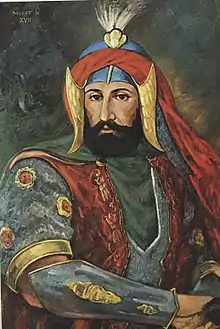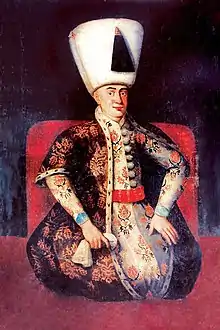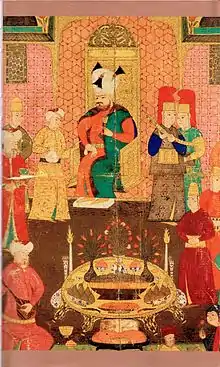Murad IV
Murad IV (Ottoman Turkish: مراد رابع, Murād-ı Rābiʿ; Turkish: IV. Murat, 27 July 1612 – 8 February 1640) was the Sultan of the Ottoman Empire from 1623 to 1640, known both for restoring the authority of the state and for the brutality of his methods. Murad IV was born in Constantinople, the son of Sultan Ahmed I (r. 1603–17) and Kösem Sultan.[2] He was brought to power by a palace conspiracy in 1623, and he succeeded his uncle Mustafa I (r. 1617–18, 1622–23). He was only 11 when he ascended the throne. His reign is most notable for the Ottoman–Safavid War (1623–1639), of which the outcome would partition the Caucasus between the two Imperial powers for around two centuries, while it also roughly laid the foundation for the current Turkey–Iran–Iraq borders.
| Murad IV مراد رابع | |||||
|---|---|---|---|---|---|
| Ottoman Caliph Amir al-Mu'minin Kayser-i Rûm Custodian of the Two Holy Mosques | |||||
 | |||||
| 17th Sultan of the Ottoman Empire (Padishah) | |||||
| Reign | 10 September 1623 – 8 February 1640 | ||||
| Predecessor | Mustafa I | ||||
| Successor | Ibrahim | ||||
| Regent | Kösem Sultan (1623–1632) | ||||
| Born | 27 July 1612 Topkapi Palace, Constantinople, Ottoman Empire (present day Istanbul, Turkey) | ||||
| Died | 8 February 1640 (aged 27) Constantinople, Ottoman Empire (present day Istanbul, Turkey) | ||||
| Burial | Sultan Ahmed Mosque, Istanbul | ||||
| Spouse | Ayşe Sultan | ||||
| Issue | see below | ||||
| |||||
| Dynasty | Ottoman | ||||
| Father | Ahmed I | ||||
| Mother | Kösem Sultan | ||||
| Religion | Sunni Islam | ||||
| Tughra |  | ||||
Early life
Murad IV was born on 27 July 1612 to Ahmed I (reign 1603 – 1617) and his consort and later wife Kösem Sultan. After his father’s death when he was six years he was confined in the Kafes with his brothers, Suleiman, Kasim, Bayezid and Ibrahim.[3]
Grand Vizier Kemankeş Ali Pasha and Şeyhülislam Yahya Efendi were deposed from their position. They did not stop their words the next day the sultan, the child of the age of 6, was taken to the Eyüp Sultan Mausoleum. The swords of Muhammad and Yavuz Sultan Selim were besieged to him. Five days later he was circumcised.[3]
Reign
Early reign (1623–32)


Murad IV was for a long time under the control of his relatives and during his early years as Sultan, his mother, Kösem Sultan, essentially ruled through him. The Empire fell into anarchy; the Safavid Empire invaded Iraq almost immediately, Northern Anatolia erupted in revolts, and in 1631 the Janissaries stormed the palace and killed the Grand Vizier, among others. Murad IV feared suffering the fate of his elder brother, Osman II (1618–22), and decided to assert his power.
At the age of 16 in 1628, he had his brother-in-law (his sister Gevherhan Sultan's husband, who was also the former governor of Egypt), Kara Mustafa Pasha, executed for a claimed action "against the law of God".[4]
After the death of the Grand Vizier Çerkes Mehmed Pasha in the winter of Tokat, Diyarbekir Beylerbeyi Hafez Ahmed Pasha became a vizier and an emperor on 8 February 1625.[5]
The epidemic, which started in the summer of 1625 and called the plague of Bayrampaşa, spread to a threat to the population of Istanbul. On average, a thousand people died every day. The people went to the Okmeydanı, to regent themselves from this plague. The situation was worse in the countryside, but there is no one who sees what looks out of Istanbul.[5]
Absolute rule and imperial policies (1632–1640)
Murad IV tried to quell the corruption that had grown during the reigns of previous Sultans, and that had not been checked while his mother was ruling through proxy.
Executions were issued to the states, and those who came to Istanbul were executed as Jelali, Jelali being followers of Celali, the leader of the revolt in 1519 in Tokat who lead peasants acting against feudal exploitation. Murad IV shivering and brutal sultan started with this shaking.[6]
Ilyas Pasha, who took advantage of the confusion in Istanbul and dominated the Manisa and Balikesir sides, who was taught Şehname, Timurname at night and was caught in the sultan's dreams, was finally caught and brought to Istanbul and executed in front of the Sultan.[6]
Murad IV banned alcohol, tobacco, and coffee in Constantinople.[7] He ordered execution for breaking this ban.[8] He would reportedly patrol the streets and the lowest taverns of Constantinople in civilian clothes at night, policing the enforcement of his command by casting off his disguise on the spot and beheading the offender with his own hands.[9] Rivaling the exploits of Selim the Grim, he would sit in a kiosk by the water near his Seraglio Palace[9] and shoot arrows at any passerby or boatman who rowed too close to his imperial compound, seemingly for sport.[10] He restored the judicial regulations by very strict punishments, including execution, he once strangled a grand vizier for the reason that the official had beaten his mother-in-law.[9][11][12]
Fire of 1633
On 2 September 1633,[6] the big Cibali fire broke out, burning a fifth of the city. The fire started during the day when a caulker burned the shrub and the ship caulked into the walls. The fire, which spread from three branches to the city. One arm lowered towards the sea.[6] He returned from Zeyrek and walked to Atpazan. Other kollan Büyükkaraman, Küçükkaraman, Sultanmehmet (Fatih), Saraçhane, Sangürz (Sangüzel) districts were ruined. The sultan could not do anything other than watching sentence viziers, Bostancı and Yeniçeri. The most beautiful districts of Istanbul were ruined, from the Yeniodas, Mollagürani districts, Fener gate to Sultanselim, Mesihpaşa, Bali Pasha and Lutfi Pasha mosques, Şahı buhan Palace, Unkapam to Atpazarı, Bostanzade houses, Sofular Bazaar. The fire that lasted for 30 hours was only extinguished after the wind stopped. [6]
War against Safavid Iran
Murad IV's reign is most notable for the Ottoman–Safavid War (1623–39) against Persia (today Iran) in which Ottoman forces managed to conquer Azerbaijan, occupying Tabriz, Hamadan, and capturing Baghdad in 1638. The Treaty of Zuhab that followed the war generally reconfirmed the borders as agreed by the Peace of Amasya, with Eastern Armenia, Eastern Georgia, Azerbaijan, and Dagestan staying Persian, while Western Armenia, and Western Georgia stayed Ottoman.[13] Mesopotamia was irrevocably lost for the Persians.[14] The borders fixed as a result of the war, are more or less the same as the present border line between Turkey, Iraq and Iran.
During the siege of Baghdad in 1638, the city held out for forty days but was compelled to surrender.
Murad IV himself commanded the Ottoman army in the last years of the war.
Relations with the Mughal Empire
While he was encamped in Baghdad, Murad IV is known to have met ambassadors of the Mughal Emperor Shah Jahan, Mir Zarif and Mir Baraka, who presented 1000 pieces of finely embroidered cloth and even armor. Murad IV gave them the finest weapons, saddles and Kaftans and ordered his forces to accompany the Mughals to the port of Basra, where they set sail to Thatta and finally Surat.[15]
Architecture
Murad IV put emphasis on architecture and in his period many monuments were erected. The Baghdad Kiosk, built in 1635, and the Revan Kiosk, built in 1638 in Yerevan, were both built in the local styles.[16] Some of the others include the Kavak Sarayı pavilion;[17] the Meydanı Mosque; the Bayram Pasha Dervish Lodge, Tomb, Fountain, and Primary School; and the Şerafettin Mosque in Konya.
Music and poetry
Murad IV wrote many poems. He used "Muradi" penname for his poems. He also liked testing people with riddles. Once he wrote a poemic riddle and announced that whoever came with the correct answer would get a generous reward. Cihadi Bey who was also a poet from Enderun School gave the correct answer and he was promoted.[18]
Murad IV was also a composer. He has a composition called "Uzzal Peshrev".[19]
Family
- Consorts

Very little is known about the concubines of Murad IV, principally because he did not leave sons who survived his death to reach the throne, but many historians consider Ayşe Sultan as his only consort until the very end of Murad's seventeen-year reign, when a second Haseki appeared in the records. It is possible that Murad had only a single concubine until the advent of the second, or that he had a number of concubines but singled out only two as Haseki.[20]
- Sons
- Şehzade Ahmed (21 December 1628 – 1639, buried in Ahmed I Mausoleum, Blue Mosque, Istanbul)
- Şehzade Numan (1628 – 1629, buried in Ahmed I Mausoleum, Blue Mosque, Istanbul)
- Şehzade Orhan (1629 – 1629, buried in Ahmed I Mausoleum, Blue Mosque, Istanbul)
- Şehzade Hasan (March 1631 – 1632, buried in Ahmed I Mausoleum, Blue Mosque, Istanbul)
- Şehzade Suleiman (2 February 1632 – 1635, buried in Ahmed I Mausoleum, Blue Mosque, Istanbul)
- Şehzade Mehmed (11 August 1633 – 11 January 1640, buried in Ahmed I Mausoleum, Blue Mosque, Istanbul)
- Şehzade Osman (9 February 1634 – 1635, buried in Ahmed I Mausoleum, Blue Mosque, Istanbul)
- Şehzade Alaeddin (26 August 1635 – 1637, buried in Ahmed I Mausoleum, Blue Mosque, Istanbul)
- Şehzade Selim (1637 – 1640, buried in Ahmed I Mausoleum, Blue Mosque, Istanbul)
- Şehzade Mahmud (15 May 1638 – 1638, buried in Ahmed I Mausoleum, Blue Mosque, Istanbul)
- Daughters
Murad had several daughters, among whom were:
- Kaya Sultan (1633–1659, buried in Mustafa I Mausoleum, Hagia Sophia Mosque, Istanbul),[21] married August 1644, Melek Ahmed Pasha;[22][23][21][24][25]
- Safiye Sultan (buried in Ahmed I Mausoleum, Blue Mosque, Istanbul),[21] married 1659, Sarı Hasan Pasha;[22]
- Rukiye Sultan (died 1696, buried in Ahmed I Mausoleum, Blue Mosque, Istanbul),[21] married firstly 1663, Şeytan Divrikli Ibrahim Pasha, Vizier, married secondly 1693 Gürcü Mehmed Pasha.[22]
Death
Murad IV died from cirrhosis in Constantinople at the age of 27 in 1640.[26]
Rumours had circulated that on his deathbed, Murad IV ordered the execution of his mentally disabled brother, Ibrahim (reigned 1640–48), which would have meant the end of the Ottoman line. However, the order was not carried out.[27]
In popular culture
In the TV series Muhteşem Yüzyıl: Kösem, Murad IV is portrayed by Cağan Efe Ak as a child, and Metin Akdülger as Sultan.[28]
References
- Ali Aktan, (1995), Osmanlılar İlim ve İrfan Vakfı, p. 202 (in Turkish)
- Finkel, Caroline (2005). Osman's Dream: The Story of the Ottoman Empire, 1300-1923. New York: Basic Books. p. 197. ISBN 978-0-465-02396-7.
- Sakaoğlu 2015, p. 224.
- Accounts and Extracts of the Manuscripts in the Library of the King of France. 2. R. Faulder. 1789. p. 51.
The sultan Morad put him to death in the year 1037 [AH], for some action which was contrary to the law of God.
- Sakaoğlu 2015, p. 225.
- Sakaoğlu 2015, p. 232.
- Hopkins, Kate (24 March 2006). "Food Stories: The Sultan's Coffee Prohibition". Archived from the original on 20 November 2012. Retrieved 12 September 2006.
- Hari, Johann (2015). Chasing the Scream: The First and Last Days of the War on Drugs. Bloomsbury USA. p. 262. ISBN 978-1620408902.
- Davis, William Stearns (1922). A short history of the Near East: from the founding of Constantinople (330 A.D. to 1922). New York: The Macmillan Company. pp. 259–260.
- McCullagh, Francis (1910). The Fall of Abd-ul-Hamid. London: Methuen & Co. Ltd. p. 72.
- İnalcık, Halil; Imber, Colin (1989). The Ottoman Empire : the classical age, 1300-1600. New Rochelle, N.Y.: Aristide D. Caratzas. p. 99. ISBN 0-89241-388-3.
- Traian Stoianovich (1 January 1994). Balkan Worlds: The First and Last Europe. M.E. Sharpe. p. 57. ISBN 978-0-7656-3851-9.
- Wallimann, Isidor; Dobkowski, Michael N. (March 2000). Genocide and the Modern Age: Etiology and Case Studies of Mass Death. ISBN 9780815628286. Retrieved 30 December 2014.
- Roemer (1989), p. 285
- Farooqi, N. R. (1989). Mughal-Ottoman relations: a study of political & diplomatic relations between Mughal India and the Ottoman Empire, 1556-1748. Idarah-i Adabiyat-i Delli. Retrieved 14 June 2015.
- Artan, Tülay (2008). "Questions of Ottoman Identity and Architectural History". In Arnold, Dana; et al. (eds.). Rethinking Architectural Historiography. London: Routledge. pp. 85–109, page 98. ISBN 978-0-415-36082-1.
- Müller-Wiener, Wolfgang (1988). "Das Kavak Sarayı Ein verlorenes Baudenkmal Istanbuls". Istanbuler Mitteilungen. 38: 363–376.
- "IV. Murad ve Şairliği". 7 July 2014.
- "Sultan IV. Murad - Uzzâl Peşrev" – via www.fikriyat.com.
- Leslie P. Peirce (1993). The Imperial Harem: Women and Sovereignty in the Ottoman Empire. Oxford University Press. pp. 107–108. ISBN 978-0-19-508677-5.
- Hafiz Hueseyin Ayvansaray-i (2000). The Garden of the Mosques: Hafiz Hüseyin Al-Ayvansarayî's Guide to the Muslim Monuments of Ottoman Istanbul. Brill. pp. 10, 25. ISBN 978-9-004-11242-1.
- Mustafa Çağatay Uluçay (2011). Padişahların kadınları ve kızları. Ankara, Ötüken. pp. 80–90.
- Murphey, Rhoads (1 January 2007). Studies on Ottoman Society and Culture, 16th-18th Centuries. Ashgate Publishing Company. p. 214. ISBN 978-0-7546-5931-0.
- Ayvansarayı̂, Hafız Hüseyin; Sâtı, Ali; Besîm, Süleyman (2001). Hadı̂katü'l-cevâmiʻ: İstanbul câmileri ve diğer dı̂nı̂-sivil miʻmârı̂ yapılar. İşaret. p. 46. ISBN 978-9-753-50118-7.
İsmihân Sultân bint-i Murâd Hân-ı Râbi'
- Kal'a, Ahmet; Tabakoğlu, Ahmet (1999). İstanbul su külliyâtı: Vakıf su defterleri : İlmühaber 4 (1856–1928). İstanbul Araştırmaları Merkezi. pp. 76–7. ISBN 978-9-758-21504-1.
merhume İsmi- hân Kaya Sultân tâbe serâhâ
- Selcuk Aksin Somel, Historical Dictionary of the Ottoman Empire, 2003, p.201
- Barber, Noel (1973). The Sultans. New York: Simon and Schuster. p. 87.
- "Muhteşem Yüzyıl Kösem'in 4. Murad'ı Metin Akdülger kimdir?" (in Turkish). Retrieved 6 November 2017.
Sources
- Roemer, H. R. (1986). "The Safavid Period". The Cambridge History of Iran: The Timurid and Safavid Periods. VI. Cambridge: Cambridge University Press. pp. 189–350. ISBN 0521200946.
- Sakaoğlu, Necdet (2008). Bu mülkün kadın sultanları: Vâlide sultanlar, hâtunlar, hasekiler, kadınefendiler, sultanefendiler. Oğlak Yayıncılık. p. 303.
- Sakaoğlu, Necdet (2015). Bu Mülkün Sultanları. Alfa Yayıncılık. ISBN 978-6-051-71080-8.
External links
![]() Media related to Murad IV at Wikimedia Commons
Media related to Murad IV at Wikimedia Commons
- . Encyclopædia Britannica. 19 (11th ed.). 1911. p. 14.
Murad IV Born: July 27, 1612 Died: February 8, 1640 | ||
| Regnal titles | ||
|---|---|---|
| Preceded by Mustafa I |
Sultan of the Ottoman Empire 10 September 1623 – 9 February 1640 with Kösem Sultan (1623–1632) |
Succeeded by İbrahim |
| Sunni Islam titles | ||
| Preceded by Mustafa I |
Caliph Ottoman Dynasty 10 September 1623 – 9 February 1640 |
Succeeded by İbrahim |
.svg.png.webp)